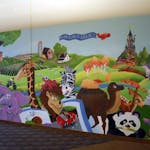Tuesday's blustery weather wasn't the only departure from the norm for some of Minnesota's 800,000 students on their first day of school.
Novelties such as a principal dressed as an astronaut, dead bumblebees and greetings in Spanish set the tone for kids who trooped off to some of the 100 schools in Minnesota called "magnet," or "specialty" schools.
Such schools focus on particular areas of study, such as science and math, foreign language and arts. In some districts -- Anoka-Hennepin, for instance -- magnets have become an increasingly large part of the learning landscape. With its first magnet school established in 2004, Anoka-Hennepin now has six magnet schools, and three additional magnet school programs within regular district schools.
More broadly, a sampling of Twin Cities school districts Tuesday found scattered reports of late buses but few big glitches plaguing what can often be a generally hectic first day of school. In Anoka-Hennepin, where thousands of kids were moved to new schools due to eight school closings, that massive transfer went without a major hitch, said district officials.
One weather-related close call occurred in Minnetonka after wicked winds knocked out power to the stoplight at Minnetonka High School's main entrance. Crews from Xcel Energy Inc. restored power a half-hour before classes began, averting potential gridlock, schools spokeswoman Janet Swiecichowski said.
In a school with more than 2,800 students, "that could've been messy," she said.
At Minnesota's magnet schools, though, things were definitely different. Twenty-two of the state's 338 school districts have magnet schools. Nationwide, there are 4,000 such schools. Initially, magnets were created to help integrate schools. Now, they're also being used to help attract students to districts or keep current students from going elsewhere. Also, they're for students who want to specialize in particular study areas. Recently, magnets have been emphasizing immersion in foreign languages and the study of science, technology, engineering and mathematics.
Kids arriving at Richfield Dual Language School on Tuesday morning were met with greetings of "hola" and "buenos dias."
With 350 students in grades K-3, Richfield Dual Language specializes in Spanish-language learning, though students will use English in such areas as art and physical education. For Robert and Jennifer Robitaille's daughter, Coco, and her fellow native English-speaking kindergartners, they'll spend the first weeks not just adjusting to the classroom routine but also to classes taught entirely in Spanish.
"We warned her she'll feel isolated at first," Robert Robitaille said. But "with time, it will start to make sense." The Robitailles plan to drive 80 miles each weekday to transport their daughter to and from school.
"It's just a valuable, priceless gift to give your child a second language," Jennifer Robitaille said.
Good flying weather
At St. Paul's Farnsworth Aerospace Secondary School, Principal Troy Vincent dressed in an astronaut suit to welcome the school's 600 would-be astronauts, engineers, scientists and doctors back to class. He told them at an assembly that they were getting a field trip to Magic Quest, at Mall of America, to celebrate a 14 percent boost in last spring's state test scores.
"I'm going to get you off running," he told the school's fifth- and sixth-graders. "You did remarkable as a student group. ... Whatever career you choose, we need to get you ready. You've got people supporting you. You will not fail."
Sixth-grader Anthony Becker was glad to be back at Farnsworth. Becker sat in one of the seven flight simulators in the school's basement going through his preflight checklist, calculating fuel costs, checking the weather forecast, and testing the wings and gears of his aircraft to be sure they were in working order. Then, with permission from another student playing the role of the air traffic controller, Becker "took off" from Holman Field for short flight around St. Paul as part of his first aviation lesson of the year.
"I missed it," he said while shifting levers and studying the instrument panel. "It's kind of like a video game, but you learn what it's like to be a pilot. It's fun learning."
Some second-graders at Garlough Environmental Magnet School in West St. Paul spent part of the morning making observations in a rain garden outside the school. They drew pictures of flowers and reported a live caterpillar and dead bumblebees. One student pointed out the roots of a dead plant to his teacher.
"Can you use a word to help me remember what that is?" teacher Kim Zellmer said.
"A root," said the boy.
"Yes, a root," Zellmer said, encouraging him to write it down.
Garlough became a magnet school in 2007, teaming with nearby Dodge Nature Center to give students an education infused with extra science, technology and math. Students get at least half an hour a week with a Dodge naturalist, and classes often head over to the center for lessons on everything from beehives to maple syruping. Garlough's enrollment has surged to 420 students this fall, up from 280 four years ago.
The West St. Paul-Mendota Heights-Eagan district recently applied for federal grant funding that could provide nearly $7 million over three years to turn three more of its eight schools into magnets. That plan calls for Moreland Elementary in West St. Paul to focus on arts and health sciences and Pilot Knob Elementary, in Eagan, to emphasize science, technology, math and engineering (STEM). Heritage Middle, also in West St. Paul, is taking steps to become an environmental STEM school, picking up where Garlough leaves off.
Staff writers Kelly Smith, Sarah Lemagie, Tim Harlow, and Corey Mitchell contributed to this report. Norman Draper • 612-673-4547
For a video report on the first day of school, go to startribune.com/video.



